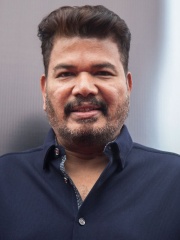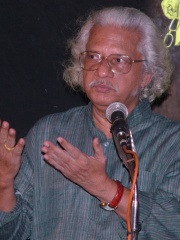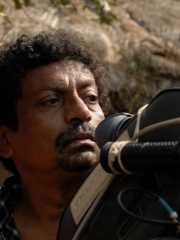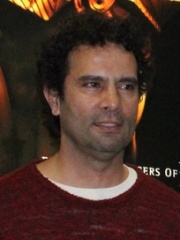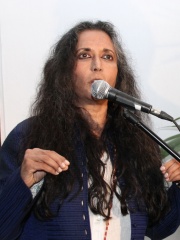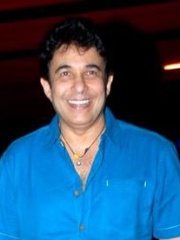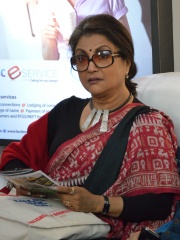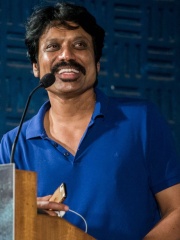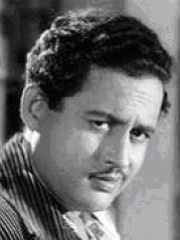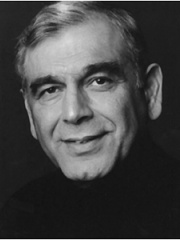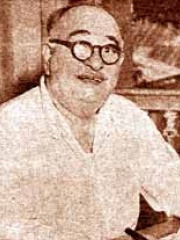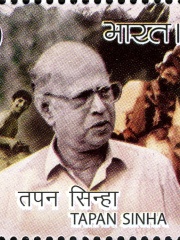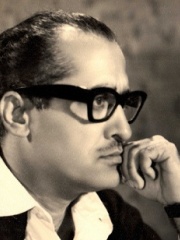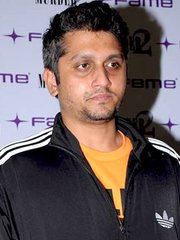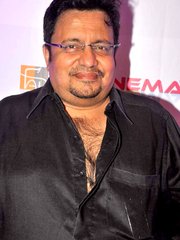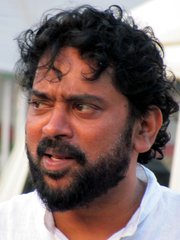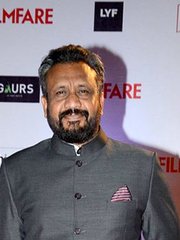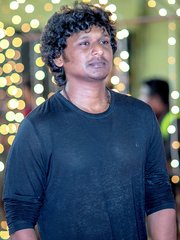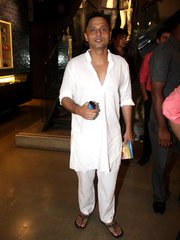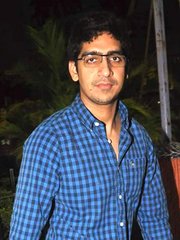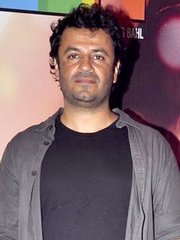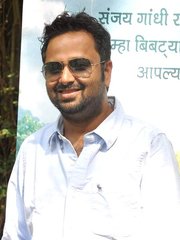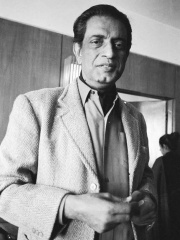
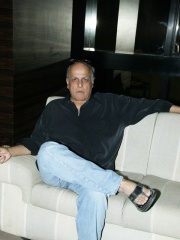
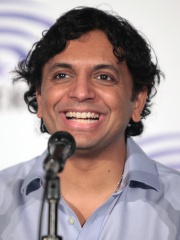
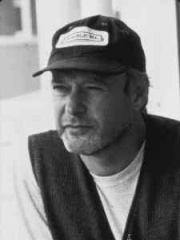

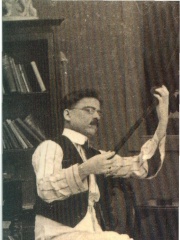
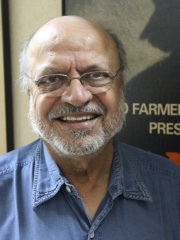
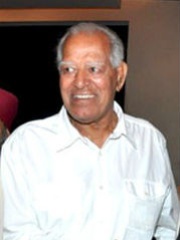
The Most Famous
FILM DIRECTORS from India
This page contains a list of the greatest Indian Film Directors. The pantheon dataset contains 2,041 Film Directors, 87 of which were born in India. This makes India the birth place of the 6th most number of Film Directors behind Italy, and Germany.
Top 10
The following people are considered by Pantheon to be the top 10 most legendary Indian Film Directors of all time. This list of famous Indian Film Directors is sorted by HPI (Historical Popularity Index), a metric that aggregates information on a biography's online popularity. Visit the rankings page to view the entire list of Indian Film Directors.

1. Satyajit Ray (1921 - 1992)
With an HPI of 70.38, Satyajit Ray is the most famous Indian Film Director. His biography has been translated into 127 different languages on wikipedia.
Satyajit Ray (Bengali: [ˈʃotːodʒit ˈrae̯] ; 2 May 1921 – 23 April 1992) was an Indian film director, screenwriter, author, lyricist, magazine editor, illustrator, calligrapher, and composer. He is widely considered to be one of the greatest and most influential film directors in the history of cinema. He is celebrated for works including The Apu Trilogy (1955–1959), The Music Room (1958), The Big City (1963), Charulata (1964), and the Goopy–Bagha trilogy (1969–1992).[a] Ray was born in Calcutta to author Sukumar Ray and Suprabha Ray. Starting his career as a commercial artist, Ray was drawn into independent film-making after meeting French filmmaker Jean Renoir and viewing Vittorio De Sica's Italian neorealist film Bicycle Thieves (1948) during a visit to London. Ray directed 36 films, including feature films, documentaries, and shorts. Ray's first film, Pather Panchali (1955), won eleven international prizes, including the inaugural Best Human Document award at the 1956 Cannes Film Festival. This film, along with Aparajito (1956) and Apur Sansar (The World of Apu) (1959), form The Apu Trilogy. Ray did the scripting, casting, scoring, and editing for the movie and designed his own credit titles and publicity material. He also authored several short stories and novels, primarily for young children and teenagers. Popular characters created by Ray include Feluda the sleuth, Professor Shonku the scientist, Tarini Khuro the storyteller, and Lalmohan Ganguly the novelist. Ray received many major awards in his career, including a record thirty-seven Indian National Film Awards which includes Dadasaheb Phalke Award, a Golden Lion, a Golden Bear, two Silver Bears, many additional awards at international film festivals and ceremonies, and an Academy Honorary Award in 1992. In 1978, he was awarded an honorary degree by Oxford University. The Government of India honoured him with the Bharat Ratna, its highest civilian award, in 1992. On the occasion of the birth centenary of Ray, the International Film Festival of India, in recognition of the auteur's legacy, rechristened in 2021 its annual Lifetime Achievement Award to the "Satyajit Ray Lifetime Achievement Award". In 2024, Forbes ranked Ray as the 8th greatest film director (worldwide) of all time in its list of "The 30 Greatest Film Directors of All Time."

2. Mahesh Bhatt (b. 1948)
With an HPI of 66.86, Mahesh Bhatt is the 2nd most famous Indian Film Director. His biography has been translated into 28 different languages.
Mahesh Bhatt (pronounced [məˈɦeːʃ ˈbʱəʈ] ; born 20 September 1948) is an Indian film director, producer and screenwriter known for his works in Hindi cinema. Known for his unconventional narratives and exploration of bold themes, he was one of the most prominent filmmakers in 80s and 90s Hindi cinema. He has received a number of accolades, including five National Film Award and four Filmfare Awards. A notable film from his earlier period is Saaransh (1984), screened at the 14th Moscow International Film Festival. It became India's official entry for the Academy Award for Best Foreign Language Film for that year. The 1986 film Naam was his first piece of commercial cinema. In 1987, he turned producer with the film Kabzaa under the banner, Vishesh Films, with his younger brother Mukesh Bhatt. In 2013, he was inducted into the Bollywood Walk of Fame, at Bandra Bandstand, where his hand print was preserved. The son of director Nanabhai Bhatt, he went on to become one of the most recognized directors of the Indian film industry in the next decade, giving both art-house works such as Daddy (1989) and Swayam (1991), as well as commercial romantic hits, such as Aashiqui (1990) and Dil Hai Ki Manta Nahin (1991), in which he cast Pooja Bhatt with actor Aamir Khan. He next directed Sadak (1991) which was a hit and it remains his highest grossing either directed or produced by Vishesh Films. During the 1990s Mahesh won critical acclaim for Sir (1993), along with other hits such as Gumraah (1993) and Criminal (1994). In 1994 he won the National Film Award – Special Jury Award for directing Hum Hain Rahi Pyar Ke (1993). In 1996, he directed Tamanna, which won the National Film Award for Best Film on Other Social Issues. In 1999, he directed the autobiographical Zakhm, which has garnered the Nargis Dutt Award for Best Feature Film on National Integration. Thereafter, Bhatt and his brother joined hands to establish Vishesh Films and then provided stories and screenplays for over twenty films, many of which were box-office successes. Bhatt has produced multiple contemporary films such as Raaz (2002), Jism (2003), Murder (2004), Gangster (2006), Woh Lamhe (2006), Jannat (2008), Murder 2 (2011), and Aashiqui 2 (2013). Owing to differences between the brothers, Mukesh took over Vishesh Films and, in May 2021, it was publicly announced that Mahesh was no longer associated with the firm.

3. M. Night Shyamalan (b. 1970)
With an HPI of 62.97, M. Night Shyamalan is the 3rd most famous Indian Film Director. His biography has been translated into 60 different languages.
Manoj Nelliyattu "M. Night" Shyamalan ( SHAH-mə-lahn; born August 6, 1970) is an American filmmaker. His films often employ supernatural plots and twist endings. The cumulative gross of his films exceeds $3.3 billion globally. Shyamalan has received various accolades, including nominations for two Academy Awards, two BAFTA Awards and a Golden Globe. Shyamalan was born in Mahé, India, and raised in Penn Valley, Pennsylvania. His early films include Praying with Anger (1992) and Wide Awake (1998) before his breakthrough film The Sixth Sense (1999), which earned him Academy Award nominations for Best Director and Best Original Screenplay. He then released Unbreakable (2000), Signs (2002) and The Village (2004). After a string of poorly received films—Lady in the Water (2006), The Happening (2008), The Last Airbender (2010), and After Earth (2013)—he experienced a career resurgence with The Visit (2015) and Split (2016). These were followed by Glass (2019), Old (2021), Knock at the Cabin (2023), and Trap (2024). Shyamalan was also one of the executive producers and occasional director of the 20th Television science fiction series Wayward Pines (2015–2016) and the Apple TV+ psychological horror series Servant (2019–2023), for which he also served as showrunner.

4. Michael Radford (b. 1946)
With an HPI of 62.58, Michael Radford is the 4th most famous Indian Film Director. His biography has been translated into 26 different languages.
Michael James Radford (born 24 February 1946) is an English film director and screenwriter. He began his career as a documentary director and television comedy writer before transitioning into features in the early 1980s. His best-known credits include the 1984 film adaptation of George Orwell's Nineteen Eighty-Four starring John Hurt and Richard Burton (in his final role), the Shakespeare adaptation The Merchant of Venice, the true crime drama White Mischief, and the 1994 Italian-language comedy drama Il Postino: The Postman, for which he won the BAFTA Awards for Best Direction and Best Film Not in the English Language, and earned Academy Award nominations for Best Director and Best Adapted Screenplay.
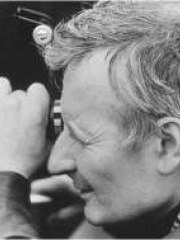
5. Lindsay Anderson (1923 - 1994)
With an HPI of 61.89, Lindsay Anderson is the 5th most famous Indian Film Director. His biography has been translated into 37 different languages.
Lindsay Gordon Anderson (17 April 1923 – 30 August 1994) was a British feature-film, theatre and documentary director, film critic, and leading light of the Free Cinema movement and of the British New Wave. He is most widely remembered for his 1968 film if...., which won the Palme d'Or at the Cannes Film Festival in 1969 and marked Malcolm McDowell's cinematic debut. He is also notable – despite not being a professional actor – for playing a minor role in the Academy Award–winning 1981 film Chariots of Fire. McDowell produced a 2007 documentary about his experiences with Anderson, Never Apologize.

6. B. R. Chopra (1914 - 2008)
With an HPI of 58.63, B. R. Chopra is the 6th most famous Indian Film Director. His biography has been translated into 21 different languages.
Baldev Raj Chopra (22 April 1914 – 5 November 2008) was a prolific Indian director and producer noted for pioneering the Hindi film industry and television series. He's known for directing notable films, such as Afsana, Ek Hi Raasta, Naya Daur, Sadhna, Kanoon, Gumrah, Hamraaz, Dhund, Pati Patni Aur Woh, Insaf Ka Tarazu and Nikaah. He also produced hit films, including Dhool Ka Phool, Waqt, Ittefaq, Aadmi Aur Insaan, Chhoti Si Baat, The Burning Train, Aaj Ki Awaaz, Baghban and the TV series, Mahabharat. He was awarded Dadasaheb Phalke Award, India's highest award in cinema, for the year 1998, and Padma Bhushan, India's third highest civilian award, in 2001. His younger brother Yash Chopra, son Ravi Chopra and nephew Aditya Chopra are also directors in the Bollywood industry. His nephew Uday Chopra is an actor and producer.

7. Dadasaheb Phalke (1870 - 1944)
With an HPI of 58.47, Dadasaheb Phalke is the 7th most famous Indian Film Director. His biography has been translated into 35 different languages.
Dhundiraj Govind Phalke (Pronunciation: [d̪ʱuɳɖiɾaːd͡ʒ pʰaːɭke]; 30 April 1870 – 16 February 1944), popularly known as Dadasaheb Phalke, was an Indian producer, director and screenwriter, widely regarded as "the Father of Indian cinema". Phalke’s debut film, Raja Harishchandra (1913), was the first Indian motion picture and is recognised as India's first full-length mythological feature film. The movie’s success marked the beginning of Indian cinema and inspired the growth of the film industry in the country. Over his career spanning nearly two decades, Phalke made 94 feature-length films and 27 short films between 1913 and 1937. His most notable works include Mohini Bhasmasur (1913), Satyavan Savitri (1914), Lanka Dahan (1917), Shri Krishna Janma (1918), and Kaliya Mardan (1919). He was known for his creativity, technical innovation and ability to adapt mythological stories for the screen, often handling multiple departments such as editing, set design and makeup himself. In recognition of his contributions to Indian cinema, the Government of India instituted the Dadasaheb Phalke Award in his honour. It remains the highest award in Indian cinema, presented annually as part of the National Film Awards to honour lifetime achievement in filmmaking.

8. Shyam Benegal (1934 - 2024)
With an HPI of 56.16, Shyam Benegal is the 8th most famous Indian Film Director. His biography has been translated into 32 different languages.
Shyam Benegal (14 December 1934 – 23 December 2024) was an Indian film director, screenwriter and documentary filmmaker. Often regarded as the pioneer of parallel cinema, he is widely considered as one of the greatest filmmakers post 1970s. He has received several accolades, including eighteen National Film Awards, a Filmfare Award and a Nandi Award. In 2005, he was honoured with the Dadasaheb Phalke Award, India's highest award in the field of cinema. In 1976, he was honoured by the Government of India with the Padma Shri, the fourth-highest civilian honour of the country, and in 1991, he was awarded the Padma Bhushan, the third-highest civilian honour for his contributions in the field of arts. He died on 23 December 2024, aged 90, at Wockhardt Hospital in Mumbai, where he was receiving treatment for chronic kidney disease. Benegal was born in Hyderabad to Sridhar B. Benegal who was prominent in the field of photography. Starting his career as a copywriter, he made his first Documentary film in Gujarati, Gher Betha Ganga (Ganges at the Doorstep) in 1962. Benegal's first four feature films – Ankur (1973), Nishant (1975), Manthan (1976) and Bhumika (1977) – made him a pioneer of the new wave film movement of that period. Benegal's "Muslim Women Trilogy" films Mammo (1994), Sardari Begum (1996), and Zubeidaa (2001) all won National Film Awards for Best Feature Film in Hindi. Benegal has won the National Film Award for Best Feature Film in Hindi seven times. He was awarded the V. Shantaram Lifetime Achievement Award in 2018.

9. Dara Singh (1928 - 2012)
With an HPI of 55.30, Dara Singh is the 9th most famous Indian Film Director. His biography has been translated into 30 different languages.
Dara Singh (born Deedar Singh Randhawa; 19 November 1928 – 12 July 2012) was an Indian professional wrestler, actor, and politician. Widely regarded as one of India’s greatest wrestlers, Singh earned international recognition during the 1950s and 1960s for his victories in both Indian and world wrestling circuits. In 1968, Singh became world champion by defeating Lou Thesz. Transitioning to cinema, Singh appeared in over 100 Hindi and Punjabi films, often portraying strong, heroic and religious characters, and is best remembered for his iconic role as Hanuman in the film Bajrangbali (1976) and in the television series Ramayan (1987–1988). He was the first sportsperson to be nominated as Member of the Rajya Sabha from 2003 to 2009, he was also awarded the Padma Shri in 1996. Singh was inducted into the Legacy wing of the WWE Hall of Fame Class of 2018.
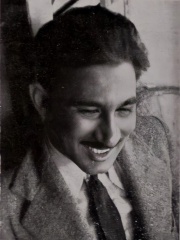
10. Khwaja Ahmad Abbas (1914 - 1987)
With an HPI of 54.22, Khwaja Ahmad Abbas is the 10th most famous Indian Film Director. His biography has been translated into 36 different languages.
Khwaja Ahmad Abbas (7 June 1914 – 1 June 1987) was an Indian film director, screenwriter, novelist, and journalist in Urdu, Hindi and English. He won four National Film Awards in India. Internationally, his films won the Palme d'Or (Golden Palm Grand Prize) at Cannes Film Festival (out of three Palme d'Or nominations) and the Crystal Globe at Karlovy Vary International Film Festival. As a director and screenwriter, he is considered one of the pioneers of Indian parallel or neo-realistic cinema. As a director, he made Hindustani films. Dharti Ke Lal (1946), about the Bengal famine of 1943, which was one of Indian cinema's first social-realist films, and opened up the overseas market for Indian films in the Soviet Union. Pardesi (1957) was nominated for the Palme d'Or. Shehar Aur Sapna (1963) won the National Film Award for Best Feature Film, while Saat Hindustani (1969) and Do Boond Pani (1972) both won the National Film Awards for Best Feature Film on National Integration. As a screenwriter, he wrote a number of neo-realistic films, such as Dharti Ke Lal (which he also directed), Neecha Nagar (1946) which won the Palme d'Or at the first Cannes Film Festival, Naya Sansar (1941), Jagte Raho (1956), and Saat Hindustani (which he also directed). He is also known for writing Raj Kapoor's films, including the Palme d'Or-nominated Awaara (1951), as well as Shree 420 (1955), Mera Naam Joker (1970), Bobby (1973) and Henna (1991). His column 'Last Page' was one of the longest-running newspaper columns in the history of Indian journalism. It began in 1935, in The Bombay Chronicle, and moved to the Blitz after the Chronicle's closure, where it continued until his death in 1987. He was awarded the Padma Shri by the Government of India in 1969. In total, his works include 74 books, 90 short stories, 3000 journalistic articles and 40 films.
People
Pantheon has 87 people classified as Indian film directors born between 1870 and 1986. Of these 87, 64 (73.56%) of them are still alive today. The most famous living Indian film directors include Mahesh Bhatt, M. Night Shyamalan, and Michael Radford. The most famous deceased Indian film directors include Satyajit Ray, Lindsay Anderson, and B. R. Chopra. As of April 2024, 16 new Indian film directors have been added to Pantheon including Mohit Suri, Payal Kapadia, and Neeraj Vora.
Living Indian Film Directors
Go to all RankingsMahesh Bhatt
1948 - Present
HPI: 66.86
M. Night Shyamalan
1970 - Present
HPI: 62.97
Michael Radford
1946 - Present
HPI: 62.58
S. Shankar
1963 - Present
HPI: 53.99
Adoor Gopalakrishnan
1941 - Present
HPI: 52.98
Goutam Ghose
1950 - Present
HPI: 52.72
Tarsem Singh
1961 - Present
HPI: 51.99
Deepa Mehta
1950 - Present
HPI: 51.67
Deepak Tijori
1961 - Present
HPI: 51.54
Tariq Anwar
1945 - Present
HPI: 50.32
Aparna Sen
1945 - Present
HPI: 50.02
S. J. Suryah
1968 - Present
HPI: 49.95
Deceased Indian Film Directors
Go to all RankingsSatyajit Ray
1921 - 1992
HPI: 70.38
Lindsay Anderson
1923 - 1994
HPI: 61.89
B. R. Chopra
1914 - 2008
HPI: 58.63
Dadasaheb Phalke
1870 - 1944
HPI: 58.47
Shyam Benegal
1934 - 2024
HPI: 56.16
Dara Singh
1928 - 2012
HPI: 55.30
Khwaja Ahmad Abbas
1914 - 1987
HPI: 54.22
Guru Dutt
1925 - 1964
HPI: 53.58
Ismail Merchant
1936 - 2005
HPI: 53.54
Ardeshir Irani
1886 - 1969
HPI: 51.55
Tapan Sinha
1924 - 2009
HPI: 51.45
Nasir Hussain
1931 - 2002
HPI: 49.59
Newly Added Indian Film Directors (2025)
Go to all RankingsMohit Suri
1981 - Present
HPI: 38.78
Payal Kapadia
1986 - Present
HPI: 37.84
Neeraj Vora
1963 - 2017
HPI: 36.60
Santosh Sivan
1964 - Present
HPI: 35.28
Anubhav Sinha
1965 - Present
HPI: 33.62
Lokesh Kanagaraj
1986 - Present
HPI: 33.43
Sujoy Ghosh
1966 - Present
HPI: 33.35
Resul Pookutty
1971 - Present
HPI: 32.51
Ayan Mukerji
1983 - Present
HPI: 31.87
Vikas Bahl
HPI: 31.64
Nikkhil Advani
1971 - Present
HPI: 31.51
Shonali Bose
1965 - Present
HPI: 31.34
Overlapping Lives
Which Film Directors were alive at the same time? This visualization shows the lifespans of the 23 most globally memorable Film Directors since 1700.

